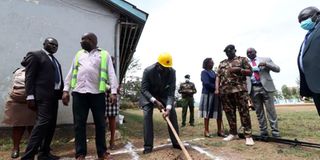State to allow investors to build standalone junior high schools

Education CS Prof. George Magoha with Starehe sub-county education and security officials during the groundbreaking ceremony for the construction of CBC classrooms at Pumwani Boys on July 13, 2022.
What you need to know:
- The initial plan was for junior high to be part of either secondary or primary schools.
- According to a task force report, junior high was proposed to be hosted in secondary schools with a majority of the students expected to be placed in day secondary schools.
- The ministry is working with private schools and the other stakeholders to ensure that there will be adequate infrastructure to accommodate the 1.2 million students who are set to graduate from Grade Six in December to join Grade Seven in January.
Private investors will build standalone junior secondary schools to accommodate students ahead of the roll-out in January in what may substantially change the structure of the education sector.
The initial plan was for junior high to be part of either secondary or primary schools.
“There are those private investors who are building standalone junior and we are encouraging them to do so. There is one in Mombasa,” Education Cabinet Secretary George Magoha said.
The ministry is working with private schools and the other stakeholders to ensure that there will be adequate infrastructure to accommodate the 1.2 million students who are set to graduate from Grade Six in December to join Grade Seven in January.
Share a compound
The ministry will be rolling out the Competency Based Curriculum (CBC) in secondary schools next year.
Prof Magoha said the government has already completed the construction of 11,000 classrooms in phase one.
The CS launched the construction of over 3,500 classrooms for phase two this month.
The CS said the ministry is also banking on spaces in primary schools that share a compound with secondary schools as well as in private primary and secondary schools.
Primary schools in northeastern region have also been earmarked to host junior secondary school, Prof Magoha yesterday in Busia.
In total, the CS said, the government expects that there will be 5,000 classrooms in private schools and 5,000 in public schools.
According to a task force report, junior high was proposed to be hosted in secondary schools with a majority of the students expected to be placed in day secondary schools.
Nearly 70 per cent of secondary education institutions are day schools. The task force report had projected a deficit of over 20,000 classrooms in secondary schools.
On infrastructure development, the Ministry of Education is also banking on the Secondary Education Quality Improvement Programme sponsored by the World Bank which is building classrooms and laboratories in selected schools. The programme started in 2017 and is projected to cost Sh8.2 billion in six years.
It is meant to benefit schools that are educationally and economically disadvantaged.
The projects target 7,852 public primary schools and 2,147 public secondary schools.
The schools were identified based on the high incidence of poverty, low retention rates and low transition rates to secondary institutions.
The government is also putting in place measures to ensure that Grade Seven textbooks are supplied by January.
The government supplies books to students and a ratio of 1:1.
The Kenya Institute of Curriculum Development is engaging publishers to ensure that textbooks for Grade Seven learners are ready before January.
The junior secondary school will comprise Grades Seven, Eight and Nine.
The students will study 12 core subjects and choose a minimum of one and a maximum of two from a pool of seven optional subjects.
Students will undergo a rigorous career guidance programme to enable them to choose subjects in line with their career paths of interest at senior secondary school.
Curriculum designs for the Grade Seven books have been distributed to secondary schools.
The government plans to start distributing textbooks in November.
Private schools
The Teachers Service Commission (TSC) is in the process of training 116,024 secondary school teachers from both public and private schools ahead of the junior secondary rollout.
TSC is also in the process of transferring P1 teachers with degree qualifications from primary schools to secondary schools with over 1,000 teachers already transferred moved.
The Sunday Nation yesterday learnt that more primary school teachers have begun receiving transfer letters to secondary schools.
Meanwhile, Prof Magoha has appointed Mr Cyrus Gituai to chair the Kenya Universities and Colleges Central Placement Service for a three-year term. He will take over from Mr Joe Ager whose term has come to an end.





